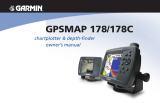
Installing the Transducer on a Transom
Mounting Location Considerations
• The transducer should be mounted as close to the center of
the boat as possible.
• The transducer should not be mounted behind strakes, struts,
fittings, water intake or discharge ports, or anything that
creates air bubbles or causes the water to become turbulent.
The transducer must be in clean (non-turbulent) water for
optimal performance.
• The transducer should not be mounted in a location where it
might be jarred when launching, hauling, or storing.
• On single-drive boats, the transducer must not be mounted in
the path of the propeller.
The transducer can cause cavitation that can degrade the
performance of the boat and damage the propeller.
• On twin-drive boats, the transducer should be mounted
between the drives, if possible.
Installing the Transom-Mount Hardware
NOTICE
If you are mounting the bracket on fiberglass with screws, it is
recommended to use a countersink bit to drill a clearance
counterbore through only the top gel-coat layer. This will help to
avoid any cracking in the gel-coat layer when the screws are
tightened.
The cables connected to the transducer should not be cut,
because cutting the transducer cables voids your warranty.
1
Position the transducer mount
À
so the center of the bottom
of the transducer is level with the bottom edge of the transom
and is parallel to the water line.
2
Align the transducer parallel to the water line
Á
, and mark the
center location of the two outer holes and the center hole of
the transducer mount.
3
Wrap a piece of tape around a 4 mm (
5
/
32
in.) bit at 15 mm
(
19
/
32
in.) from the point of the bit, to avoid drilling the pilot
holes too deep.
4
If you are installing the bracket on fiberglass, place a piece of
tape over the pilot-hole location to reduce cracking of the gel
coat.
5
Using the 4 mm (
5
/
32
in.) bit, drill the pilot holes approximately
15 mm (
19
/
32
in.) deep at the marked locations.
6
Apply marine sealant to the included 20 mm screws, and
attach the transducer assembly to the transom.
NOTE: The third screw in the lower center screw hole
stabilizes the mount.
7
If you must route the cable through the transom, choose a
pilot-hole location well above the waterline
Ã
and mark it.
8
Place a cable clamp on the transducer cable
Ä
,
approximately one third of the distance between the
transducer and the top of the transom or the pilot hole.
9
Mark the pilot-hole location for the cable clamp, and using a
3.2 mm (
1
/
8
in.) bit, drill a pilot hole approximately 10 mm
(
3
/
8
in.) deep.
10
Apply marine sealant to the included 12 mm screw, and
attach the cable clamp to the transom.
11
Repeat steps 8 through 10 to install the other cable clamp
approximately two thirds of the distance between the
transducer and the top of the transom or the pilot hole.
12
If you marked a pilot hole in step 9, choose the appropriate
drill bit and drill a pass-through hole completely through the
transom:
• If you have the 4-pin cable, use a 16 mm (
5
/
8
in.) drill bit.
• If you have the 8-pin cable or the 12-pin cable, use a
25 mm (1 in.) drill bit.
13
Route the transducer cable to the sounder:
• If you are routing the cable using a pass-through hole,
feed it through the hole you drilled in step 12, and install
the cable-entry cover
Ã
(Installing the Cable-Entry Cover,
page 2).
• If you are not routing the cable using a pass-through hole,
route the cable up and over the top of the transom
Å
.
Avoid routing the cable close to electrical wires or other
sources of electrical interference.
Installing the Cable-Entry Cover
If you routed the cable through the transom after you installed
the transducer, you should install the cable-entry cover to keep
water from entering your boat.
1
Place the cable-entry cover
À
over the hole and the cable,
with the opening pointing downward, and mark the location of
the two pilot holes.
2
Remove the cable-entry cover, and, using a 3.2 mm (
1
/
8
in.)
bit, drill the pilot holes approximately 10 mm (
3
/
8
in.) deep.
2 Transom-Mount Transducer Installation Instructions




